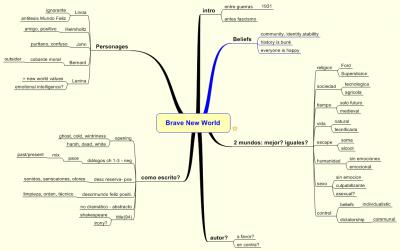Samstag, 5. Juni 2010
Fordism and society
anaconda178, 15:17h
The World State is built upon the principles of Henry Ford's assembly line—mass production, homogeneity, predictability, and consumption of disposable consumer goods. At the same time as the World State lacks any supernatural-based religions, Ford himself is revered as a deity, and characters celebrate Ford Day and swear oaths by his name (e.g., "By Ford!"). In this sense, some fragments of traditional religion are present, such as Christian crosses, which had their tops cut off in order to be changed to a "T". The World State calendar numbers years in the "AF" era—"After Ford"—with year 1 AF being equivalent to 1908 AD, the year in which Ford's first Model T rolled off his assembly line. The novel's Gregorian calendar year is AD 2540, but it is referred to in the book as AF 632.
From birth, members of every class are indoctrinated by recorded voices repeating slogans while they sleep (called "hypnopædia" in the book) to believe that their own class is best for them. Any residual unhappiness is resolved by an antidepressant and hallucinogenic drug called soma (named for an intoxicating drink in ancient India) distributed by the Arch-Community Songster of Canterbury, a secularised version of the Christian sacrament of Communion ("The Body of Christ").
The biological techniques used to control the populace in Brave New World do not include genetic engineering; Huxley wrote the book before the structure of DNA was known. However, Gregor Mendel's work with inheritance patterns in peas had been re-discovered in 1900 and the eugenics movement, based on artificial selection, was well established. Huxley's family included a number of prominent biologists including Thomas Huxley, half-brother and Nobel Laureate Andrew Huxley, and brother Julian Huxley who was a biologist and involved in the eugenics movement. Nonetheless, Huxley emphasizes conditioning over breeding (see nature versus nurture); as science writer Matt Ridley put it, Brave New World describes an "environmental not a genetic hell". Human embryos and fetuses are conditioned via a carefully designed regimen of chemical (such as exposure to hormones and toxins), thermal (exposure to intense heat or cold, as one's future career would dictate), and other environmental stimuli, although there is an element of selective breeding as well.

http://www.xtec.es/~jmaguire/teachers/reviews/brave%20new%20world%201.jpg
From birth, members of every class are indoctrinated by recorded voices repeating slogans while they sleep (called "hypnopædia" in the book) to believe that their own class is best for them. Any residual unhappiness is resolved by an antidepressant and hallucinogenic drug called soma (named for an intoxicating drink in ancient India) distributed by the Arch-Community Songster of Canterbury, a secularised version of the Christian sacrament of Communion ("The Body of Christ").
The biological techniques used to control the populace in Brave New World do not include genetic engineering; Huxley wrote the book before the structure of DNA was known. However, Gregor Mendel's work with inheritance patterns in peas had been re-discovered in 1900 and the eugenics movement, based on artificial selection, was well established. Huxley's family included a number of prominent biologists including Thomas Huxley, half-brother and Nobel Laureate Andrew Huxley, and brother Julian Huxley who was a biologist and involved in the eugenics movement. Nonetheless, Huxley emphasizes conditioning over breeding (see nature versus nurture); as science writer Matt Ridley put it, Brave New World describes an "environmental not a genetic hell". Human embryos and fetuses are conditioned via a carefully designed regimen of chemical (such as exposure to hormones and toxins), thermal (exposure to intense heat or cold, as one's future career would dictate), and other environmental stimuli, although there is an element of selective breeding as well.

http://www.xtec.es/~jmaguire/teachers/reviews/brave%20new%20world%201.jpg
... comment
pstz,
Montag, 21. Juni 2010, 22:58
text source
Jan, you forgot to name the source of your/this piece of information, the text that you copied and pasted here.
P.S.
P.S.
... link
... comment